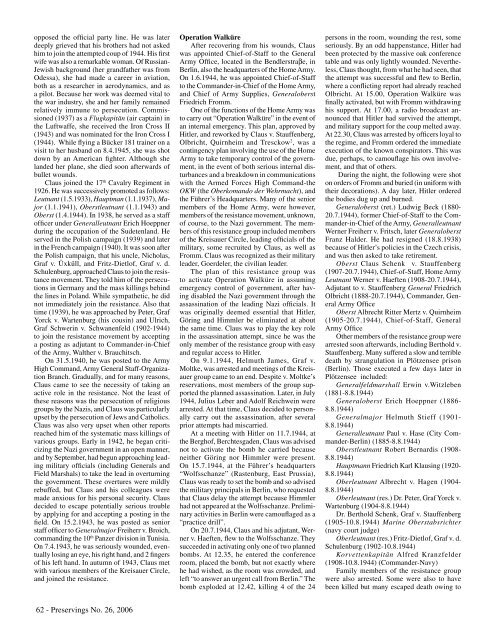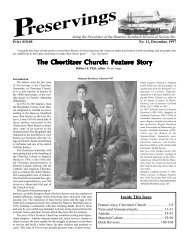Preservings $20 Issue No. 26, 2006 - Home at Plett Foundation
Preservings $20 Issue No. 26, 2006 - Home at Plett Foundation
Preservings $20 Issue No. 26, 2006 - Home at Plett Foundation
You also want an ePaper? Increase the reach of your titles
YUMPU automatically turns print PDFs into web optimized ePapers that Google loves.
opposed the official party line. He was l<strong>at</strong>er<br />
deeply grieved th<strong>at</strong> his brothers had not asked<br />
him to join the <strong>at</strong>tempted coup of 1944. His first<br />
wife was also a remarkable woman. Of Russian-<br />
Jewish background (her grandf<strong>at</strong>her was from<br />
Odessa), she had made a career in avi<strong>at</strong>ion,<br />
both as a researcher in aerodynamics, and as<br />
a pilot. Because her work was deemed vital to<br />
the war industry, she and her family remained<br />
rel<strong>at</strong>ively immune to persecution. Commissioned<br />
(1937) as a Flugkapitän (air captain) in<br />
the Luftwaffe, she received the Iron Cross II<br />
(1943) and was nomin<strong>at</strong>ed for the Iron Cross I<br />
(1944). While flying a Bücker 181 trainer on a<br />
visit to her husband on 8.4.1945, she was shot<br />
down by an American fighter. Although she<br />
landed her plane, she died soon afterwards of<br />
bullet wounds.<br />
Claus joined the 17 th Cavalry Regiment in<br />
19<strong>26</strong>. He was successively promoted as follows:<br />
Leutnant (1.5.1933), Hauptman (1.1.1937), Major<br />
(1.1.1941), Oberstleutnant (1.1.1943) and<br />
Oberst (1.4.1944). In 1938, he served as a staff<br />
officer under Generalleutnant Erich Hoeppner<br />
during the occup<strong>at</strong>ion of the Sudetenland. He<br />
served in the Polish campaign (1939) and l<strong>at</strong>er<br />
in the French campaign (1940). It was soon after<br />
the Polish campaign, th<strong>at</strong> his uncle, Nicholas,<br />
Graf v. Üxküll, and Fritz-Dietlof, Graf v. d.<br />
Schulenburg, approached Claus to join the resistance<br />
movement. They told him of the persecutions<br />
in Germany and the mass killings behind<br />
the lines in Poland. While symp<strong>at</strong>hetic, he did<br />
not immedi<strong>at</strong>ely join the resistance. Also th<strong>at</strong><br />
time (1939), he was approached by Peter, Graf<br />
Yorck v. Wartenburg (his cousin) and Ulrich,<br />
Graf Schwerin v. Schwanenfeld (1902-1944)<br />
to join the resistance movement by accepting<br />
a posting as adjutant to Commander-in-Chief<br />
of the Army, Walther v. Brauchitsch.<br />
On 31.5.1940, he was posted to the Army<br />
High Command, Army General Staff-Organiz<strong>at</strong>ion<br />
Branch. Gradually, and for many reasons,<br />
Claus came to see the necessity of taking an<br />
active role in the resistance. <strong>No</strong>t the least of<br />
these reasons was the persecution of religious<br />
groups by the Nazis, and Claus was particularly<br />
upset by the persecution of Jews and C<strong>at</strong>holics.<br />
Claus was also very upset when other reports<br />
reached him of the system<strong>at</strong>ic mass killings of<br />
various groups. Early in 1942, he began criticizing<br />
the Nazi government in an open manner,<br />
and by September, had begun approaching leading<br />
military officials (including Generals and<br />
Field Marshals) to take the lead in overturning<br />
the government. These overtures were mildly<br />
rebuffed, but Claus and his colleagues were<br />
made anxious for his personal security. Claus<br />
decided to escape potentially serious trouble<br />
by applying for and accepting a posting in the<br />
field. On 15.2.1943, he was posted as senior<br />
staff officer to Generalmajor Freiherr v. Broich,<br />
commanding the 10 th Panzer division in Tunisia.<br />
On 7.4.1943, he was seriously wounded, eventually<br />
losing an eye, his right hand, and 2 fingers<br />
of his left hand. In autumn of 1943, Claus met<br />
with various members of the Kreisauer Circle,<br />
and joined the resistance.<br />
Oper<strong>at</strong>ion Walküre<br />
After recovering from his wounds, Claus<br />
was appointed Chief-of-Staff to the General<br />
Army Office, loc<strong>at</strong>ed in the Bendlerstraβe, in<br />
Berlin, also the headquarters of the <strong>Home</strong> Army.<br />
On 1.6.1944, he was appointed Chief-of-Staff<br />
to the Commander-in-Chief of the <strong>Home</strong> Army,<br />
and Chief of Army Supplies, Generaloberst<br />
Friedrich Fromm.<br />
One of the functions of the <strong>Home</strong> Army was<br />
to carry out “Oper<strong>at</strong>ion Walküre” in the event of<br />
an internal emergency. This plan, approved by<br />
Hitler, and reworked by Claus v. Stauffenberg,<br />
Olbricht, Quirnheim and Tresckow 2 , was a<br />
contingency plan involving the use of the <strong>Home</strong><br />
Army to take temporary control of the government,<br />
in the event of both serious internal disturbances<br />
and a breakdown in communic<strong>at</strong>ions<br />
with the Armed Forces High Command-the<br />
OKW (the Oberkomando der Wehrmacht), and<br />
the Führer’s Headquarters. Many of the senior<br />
members of the <strong>Home</strong> Army, were however,<br />
members of the resistance movement, unknown,<br />
of course, to the Nazi government. The members<br />
of this resistance group included members<br />
of the Kreisauer Circle, leading officials of the<br />
military, some recruited by Claus, as well as<br />
Fromm. Claus was recognized as their military<br />
leader, Goerdeler, the civilian leader.<br />
The plan of this resistance group was<br />
to activ<strong>at</strong>e Oper<strong>at</strong>ion Walküre in assuming<br />
emergency control of government, after having<br />
disabled the Nazi government through the<br />
assassin<strong>at</strong>ion of the leading Nazi officials. It<br />
was originally deemed essential th<strong>at</strong> Hitler,<br />
Göring and Himmler be elimin<strong>at</strong>ed <strong>at</strong> about<br />
the same time. Claus was to play the key role<br />
in the assassin<strong>at</strong>ion <strong>at</strong>tempt, since he was the<br />
only member of the resistance group with easy<br />
and regular access to Hitler.<br />
On 9.1.1944, Helmuth James, Graf v.<br />
Moltke, was arrested and meetings of the Kreisauer<br />
group came to an end. Despite v. Moltke’s<br />
reserv<strong>at</strong>ions, most members of the group supported<br />
the planned assassin<strong>at</strong>ion. L<strong>at</strong>er, in July<br />
1944, Julius Leber and Adolf Reichwein were<br />
arrested. At th<strong>at</strong> time, Claus decided to personally<br />
carry out the assassin<strong>at</strong>ion, after several<br />
prior <strong>at</strong>tempts had miscarried.<br />
At a meeting with Hitler on 11.7.1944, <strong>at</strong><br />
the Berghof, Berchtesgaden, Claus was advised<br />
not to activ<strong>at</strong>e the bomb he carried because<br />
neither Göring nor Himmler were present.<br />
On 15.7.1944, <strong>at</strong> the Führer’s headquarters<br />
“Wolfsschanze” (Rastenburg, East Prussia),<br />
Claus was ready to set the bomb and so advised<br />
the military principals in Berlin, who requested<br />
th<strong>at</strong> Claus delay the <strong>at</strong>tempt because Himmler<br />
had not appeared <strong>at</strong> the Wolfsschanze. Preliminary<br />
activities in Berlin were camouflaged as a<br />
“practice drill”.<br />
On 20.7.1944, Claus and his adjutant, Werner<br />
v. Haeften, flew to the Wolfsschanze. They<br />
succeeded in activ<strong>at</strong>ing only one of two planned<br />
bombs. At 12.35, he entered the conference<br />
room, placed the bomb, but not exactly where<br />
he had wished, as the room was crowded, and<br />
left “to answer an urgent call from Berlin.” The<br />
bomb exploded <strong>at</strong> 12.42, killing 4 of the 24<br />
persons in the room, wounding the rest, some<br />
seriously. By an odd happenstance, Hitler had<br />
been protected by the massive oak conference<br />
table and was only lightly wounded. Nevertheless,<br />
Claus thought, from wh<strong>at</strong> he had seen, th<strong>at</strong><br />
the <strong>at</strong>tempt was successful and flew to Berlin,<br />
where a conflicting report had already reached<br />
Olbricht. At 15.00, Oper<strong>at</strong>ion Walküre was<br />
finally activ<strong>at</strong>ed, but with Fromm withdrawing<br />
his support. At 17.00, a radio broadcast announced<br />
th<strong>at</strong> Hitler had survived the <strong>at</strong>tempt,<br />
and military support for the coup melted away.<br />
At 22.30, Claus was arrested by officers loyal to<br />
the regime, and Fromm ordered the immedi<strong>at</strong>e<br />
execution of the known conspir<strong>at</strong>ors. This was<br />
due, perhaps, to camouflage his own involvement,<br />
and th<strong>at</strong> of others.<br />
During the night, the following were shot<br />
on orders of Fromm and buried (in uniform with<br />
their decor<strong>at</strong>ions). A day l<strong>at</strong>er, Hitler ordered<br />
the bodies dug up and burned.<br />
Generaloberst (ret.) Ludwig Beck (1880-<br />
20.7.1944), former Chief-of-Staff to the Commander-in-Chief<br />
of the Army, Generalleutnant<br />
Werner Freiherr v. Fritsch, l<strong>at</strong>er Generaloberst<br />
Franz Halder. He had resigned (18.8.1938)<br />
because of Hitler’s policies in the Czech crisis,<br />
and was then asked to take retirement.<br />
Oberst Claus Schenk v. Stauffenberg<br />
(1907-20.7.1944), Chief-of-Staff, <strong>Home</strong> Army<br />
Leutnant Werner v. Haeften (1908-20.7.1944),<br />
Adjutant to v. Stauffenberg General Friedrich<br />
Olbricht (1888-20.7.1944), Commander, General<br />
Army Office<br />
Oberst Albrecht Ritter Mertz v. Quirnheim<br />
(1905-20.7.1944), Chief-of-Staff, General<br />
Army Office<br />
Other members of the resistance group were<br />
arrested soon afterwards, including Berthold v.<br />
Stauffenberg. Many suffered a slow and terrible<br />
de<strong>at</strong>h by strangul<strong>at</strong>ion in Plötzensee prison<br />
(Berlin). Those executed a few days l<strong>at</strong>er in<br />
Plötzensee included:<br />
Generalfeldmarshall Erwin v.Witzleben<br />
(1881-8.8.1944)<br />
Generaloberst Erich Hoeppner (1886-<br />
8.8.1944)<br />
Generalmajor Helmuth Stieff (1901-<br />
8.8.1944)<br />
Generalleutnant Paul v. Hase (City Commander-Berlin)<br />
(1885-8.8.1944)<br />
Oberstleutnant Robert Bernardis (1908-<br />
8.8.1944)<br />
Hauptmann Friedrich Karl Klausing (1920-<br />
8.8.1944)<br />
Oberleutnant Albrecht v. Hagen (1904-<br />
8.8.1944)<br />
Oberleutnant (res.) Dr. Peter, Graf Yorck v.<br />
Wartenburg (1904-8.8.1944)<br />
Dr. Berthold Schenk, Graf v. Stauffenberg<br />
(1905-10.8.1944) Marine Oberstabsrichter<br />
(navy court judge)<br />
Oberleutnant (res.) Fritz-Dietlof, Graf v. d.<br />
Schulenburg (1902-10.8.1944)<br />
Korvettenkapitän Alfred Kranzfelder<br />
(1908-10.8.1944) (Commander-Navy)<br />
Family members of the resistance group<br />
were also arrested. Some were also to have<br />
been killed but many escaped de<strong>at</strong>h owing to<br />
62 - <strong>Preservings</strong> <strong>No</strong>. <strong>26</strong>, <strong>2006</strong>
















